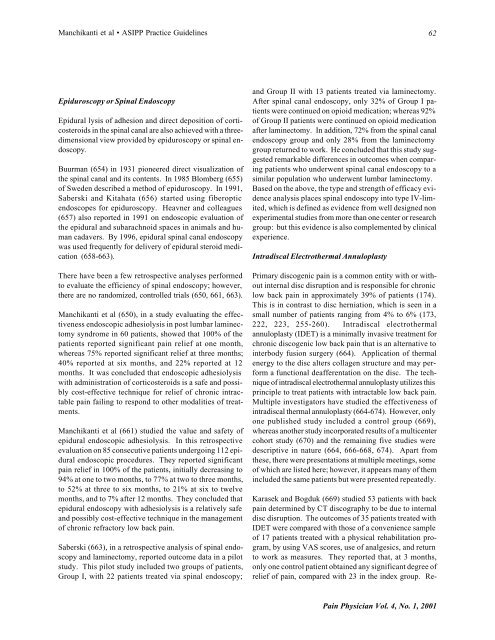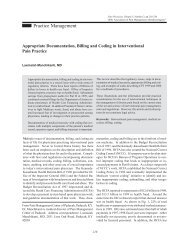ASIPP Practice Guidelines - Pain Physician
ASIPP Practice Guidelines - Pain Physician
ASIPP Practice Guidelines - Pain Physician
Create successful ePaper yourself
Turn your PDF publications into a flip-book with our unique Google optimized e-Paper software.
Manchikanti et al • <strong>ASIPP</strong> <strong>Practice</strong> <strong>Guidelines</strong><br />
62<br />
Epiduroscopy or Spinal Endoscopy<br />
Epidural lysis of adhesion and direct deposition of corticosteroids<br />
in the spinal canal are also achieved with a threedimensional<br />
view provided by epiduroscopy or spinal endoscopy.<br />
Buurman (654) in 1931 pioneered direct visualization of<br />
the spinal canal and its contents. In 1985 Blomberg (655)<br />
of Sweden described a method of epiduroscopy. In 1991,<br />
Saberski and Kitahata (656) started using fiberoptic<br />
endoscopes for epiduroscopy. Heavner and colleagues<br />
(657) also reported in 1991 on endoscopic evaluation of<br />
the epidural and subarachnoid spaces in animals and human<br />
cadavers. By 1996, epidural spinal canal endoscopy<br />
was used frequently for delivery of epidural steroid medication<br />
(658-663).<br />
There have been a few retrospective analyses performed<br />
to evaluate the efficiency of spinal endoscopy; however,<br />
there are no randomized, controlled trials (650, 661, 663).<br />
Manchikanti et al (650), in a study evaluating the effectiveness<br />
endoscopic adhesiolysis in post lumbar laminectomy<br />
syndrome in 60 patients, showed that 100% of the<br />
patients reported significant pain relief at one month,<br />
whereas 75% reported significant relief at three months;<br />
40% reported at six months, and 22% reported at 12<br />
months. It was concluded that endoscopic adhesiolysis<br />
with administration of corticosteroids is a safe and possibly<br />
cost-effective technique for relief of chronic intractable<br />
pain failing to respond to other modalities of treatments.<br />
Manchikanti et al (661) studied the value and safety of<br />
epidural endoscopic adhesiolysis. In this retrospective<br />
evaluation on 85 consecutive patients undergoing 112 epidural<br />
endoscopic procedures. They reported significant<br />
pain relief in 100% of the patients, initially decreasing to<br />
94% at one to two months, to 77% at two to three months,<br />
to 52% at three to six months, to 21% at six to twelve<br />
months, and to 7% after 12 months. They concluded that<br />
epidural endoscopy with adhesiolysis is a relatively safe<br />
and possibly cost-effective technique in the management<br />
of chronic refractory low back pain.<br />
Saberski (663), in a retrospective analysis of spinal endoscopy<br />
and laminectomy, reported outcome data in a pilot<br />
study. This pilot study included two groups of patients,<br />
Group I, with 22 patients treated via spinal endoscopy;<br />
and Group II with 13 patients treated via laminectomy.<br />
After spinal canal endoscopy, only 32% of Group I patients<br />
were continued on opioid medication; whereas 92%<br />
of Group II patients were continued on opioid medication<br />
after laminectomy. In addition, 72% from the spinal canal<br />
endoscopy group and only 28% from the laminectomy<br />
group returned to work. He concluded that this study suggested<br />
remarkable differences in outcomes when comparing<br />
patients who underwent spinal canal endoscopy to a<br />
similar population who underwent lumbar laminectomy.<br />
Based on the above, the type and strength of efficacy evidence<br />
analysis places spinal endoscopy into type IV-limited,<br />
which is defined as evidence from well designed non<br />
experimental studies from more than one center or research<br />
group: but this evidence is also complemented by clinical<br />
experience.<br />
Intradiscal Electrothermal Annuloplasty<br />
Primary discogenic pain is a common entity with or without<br />
internal disc disruption and is responsible for chronic<br />
low back pain in approximately 39% of patients (174).<br />
This is in contrast to disc herniation, which is seen in a<br />
small number of patients ranging from 4% to 6% (173,<br />
222, 223, 255-260). Intradiscal electrothermal<br />
annuloplasty (IDET) is a minimally invasive treatment for<br />
chronic discogenic low back pain that is an alternative to<br />
interbody fusion surgery (664). Application of thermal<br />
energy to the disc alters collagen structure and may perform<br />
a functional deafferentation on the disc. The technique<br />
of intradiscal electrothermal annuloplasty utilizes this<br />
principle to treat patients with intractable low back pain.<br />
Multiple investigators have studied the effectiveness of<br />
intradiscal thermal annuloplasty (664-674). However, only<br />
one published study included a control group (669),<br />
whereas another study incorporated results of a multicenter<br />
cohort study (670) and the remaining five studies were<br />
descriptive in nature (664, 666-668, 674). Apart from<br />
these, there were presentations at multiple meetings, some<br />
of which are listed here; however, it appears many of them<br />
included the same patients but were presented repeatedly.<br />
Karasek and Bogduk (669) studied 53 patients with back<br />
pain determined by CT discography to be due to internal<br />
disc disruption. The outcomes of 35 patients treated with<br />
IDET were compared with those of a convenience sample<br />
of 17 patients treated with a physical rehabilitation program,<br />
by using VAS scores, use of analgesics, and return<br />
to work as measures. They reported that, at 3 months,<br />
only one control patient obtained any significant degree of<br />
relief of pain, compared with 23 in the index group. Re-<br />
<strong>Pain</strong> <strong>Physician</strong> Vol. 4, No. 1, 2001
















